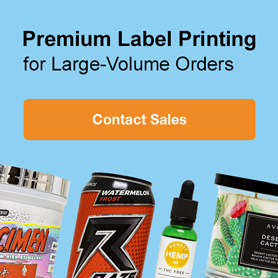Hot Foil vs. Cold Foil: Are You Using the Right Method?

Foil printing has transformed label design, offering a simple way to add shine and strengthen a label's finish. This technique has long been used by brands seeking to make their products stand out. There are two main types of foil printing: hot and cold foil. Although they look similar, they are distinctively unique, and choosing the correct method can significantly impact the look and feel of your design. Whether you're aiming for a bold, metallic shine or an embossed graphic, this article will help you understand the main advantages of hot and cold foiling, how they differentiate from one another, the materials usually used for each, and how they differ from metallic foil labels.
What is Hot Foil Stamping?
Hot foil labeling, also known as hot stamping or hot foil printing, is the oldest of the two methods. This technique adds metallic foil to an existing label using heat or pressure. It works by incorporating a custom metal die heated to 200 degrees and pressed onto a thin layer of foil. The heat activates the adhesive on the foil. It sticks to the label material in the design, resulting in a smooth, reflective, and potentially embossed effect that adds depth and elegance to the label.
What is Cold Foil Stamping?
Cold foil stamping, which can also be addressed as cold foil printing and transfer, is a newer method for label applications that use a standard print plate instead of traditional heating tools. This technique is printed in layers, allowing the product to print gradients and half-tones in various colors. Cold foil stamping works by imprinting the plated image on the label using UV-curable adhesive and UV lighting. Additionally, cold foil labels can be laminated or varnished to add protection in contrast with hot foil label printing.
What Materials Can Be Used With Hot and Coil-Foiling?
Hot foiling uses heat to apply foil to a label. Because of this, it does not work with heat-sensitive materials. Cold foiling offers more versatility when it comes to compatible label materials. Since the technique doesn't use high-temperature tools, it can be applied to most label materials, including heat-sensitive materials like direct thermal and thermal transfer.
Key Differences Between Hot and Cold Foil Stamping
Although both techniques achieve a similar effect, several differences can help you decide which is correct.
| Hot Foiling | Similarities | Cold Foiling |
|---|---|---|
| This method uses heat and pressure to press the foil against the material, adhering it through pressure. | Both techniques apply a shorter layer of foil to a surface, creating a shiny look. | Uses an adhesive and UV light instead of heat. |
| Does not work with heat-sensitive materials. | Both work with a variety of materials, including BOPP and paper. | It is best suited for specific non-porous materials such as coated paper, laminated labels, etc. Can work with heat-sensitive thermal labels. |
| Allows embossing, creating a raised effect, and adding texture and dimension to a design. | Both can be used in many industries, such as cosmetics, food and beverage. | It provides a smoother but more detailed print and is ideal for fine text and precise designs. |
| It's slower because of the setup and heating process. | This method is faster because it can be done inline with other printing processes. | |
| The heat embeds this foil into the material, making it more resistant to wear and tear and outdoor factors. | This method provides less durability because the foil sits on the material's surface but becomes just as durable as a hot foil with a top coat or laminate. |
Which Method is the Best Choice For You?
- Use Hot Foil Stamping if you want to use low embossing and for higher durability under external conditions.
- On the other hand, Cold Foil Stamping is used if you need production in a larger output with specific and delicate details.
What's the Main Difference Between Hot Foil, Cold Foil, and Metallic Foil Labels?
Metallic foil labels are not a finish; they are labels themselves that feature a shiny metallic look, and can be customized to different colors.
The key differences between metallic foil and the two types of foil printing include:
| Metallic Foil Labels | Cold Foil Stamping | Hot Foil Stamping | |
|---|---|---|---|
| Application Process | We print directly on the metal foil material. | UV adhesive transfers foil without the use of heat. | Heat and pressure press foil onto the label. |
| Shine and Reflectivity | It's shiny but doesn't highlight details as foil stamping. | Good reflectivity can handle delicate and detailed information. | Highest reflectivity, producing a vibrant effect. |
| Embossing | Metalized paper materials allow for embossed finishes. | Embossing is an additional step in the finishing process. | It permits embossing for a textured effect. |
| Durability | It depends on the material, laminate, and printing method. | The foil layer is thin and may be prone to wear and tear without a laminate or top coat. | High durability and long-lasting finish. |
| Details | Best for any foil label design. | Best for printing small and more challenging elements. | Best for bold or straightforward designs. |
| Design Flexibility | Has the most extensive availability of metallic color options and capabilities. | More minor intricate details are legible; they can print multiple metallic colors or a gradient. | It has more metallic options, but incorporating more than one metallic color into a design will require additional cost and time. |
| Material Compatibility | It comes in metalized film or paper. | Compatible with smooth and coated labels. | Works on textured, uncoated labels. |
| Production Speed | Fast turnaround since printing is done on the metalized material. | Fast, since it's applied inline during printing. | Slower since it requires an additional process after printing. |
| Cost | Budget-friendly, with no special dies needed. | More affordable and perfect for large runs, mainly if multiple foil colors are used. | Higher cost for medium to long runs due to set up and heat materials. |
| Best for | General product labeling and budget-friendly prints. | High-speed label production, detailed metallic labels. | Luxury products and embossed effects. |
Choosing the Right Foil Method for Your Labels
Foil labels offer unique advantages to elevate your design, creating a premium and eye-catching finish. Hot foiling provides durability, caution on details, and embossing, making it ideal for a high-end finish. On the other hand, cold foil printing is a more affordable solution that can add small details to a design in a fast-paced production. Choosing the correct method depends on your design, goals, material choices, and budget.



